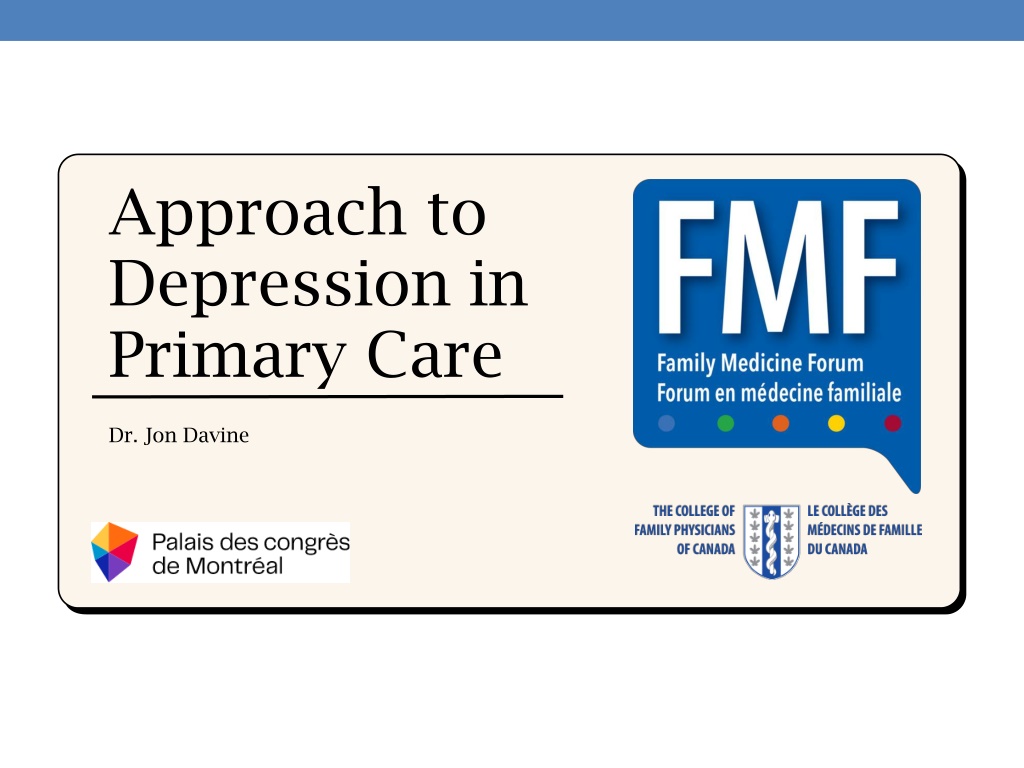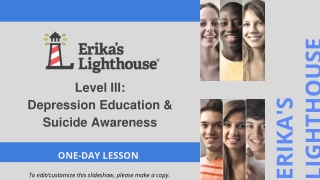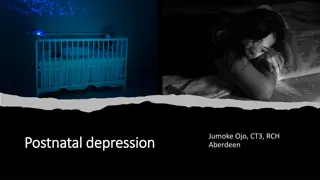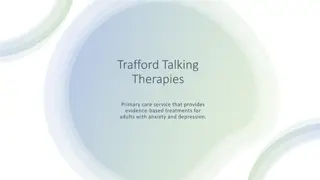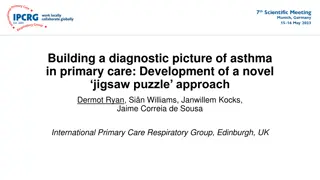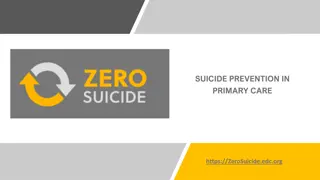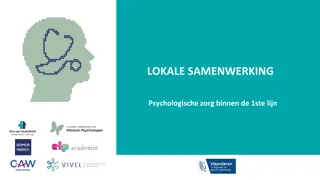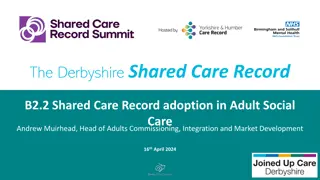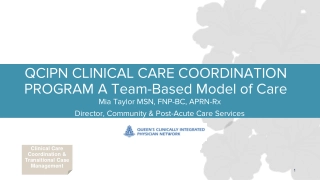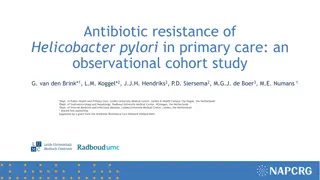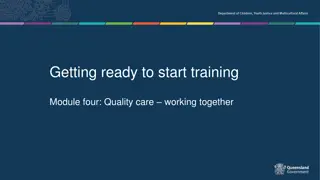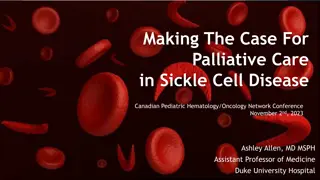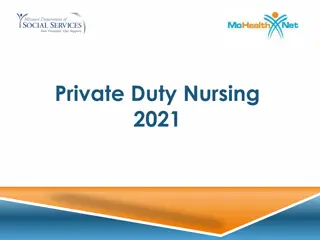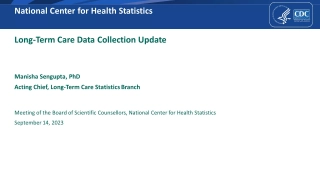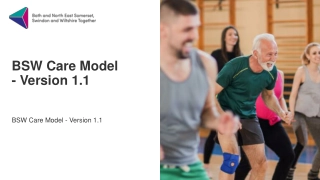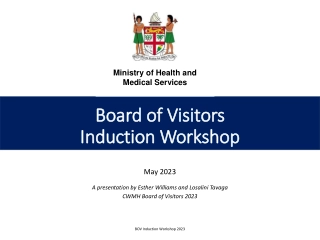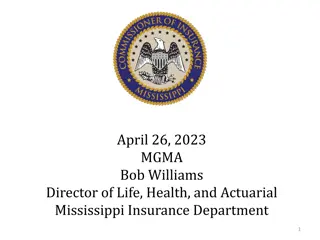Approach to Depression in Primary Care by Dr. Jon Davine
In this presentation, Dr. Jon Davine discusses the approach to depression in primary care, covering topics such as differential diagnosis, antidepressant medication selection, augmentation techniques, and treatment options like ECT and TMS. The sad state is explored through differential diagnoses, including unipolar depression, bipolar disorder, and seasonal affective disorder. Emphasis is placed on ruling out organic causes, checking alcohol use, and addressing adjustment disorder with depressed mood through counseling.
Download Presentation
Please find below an Image/Link to download the presentation.
The content on the website is provided AS IS for your information and personal use only. It may not be sold, licensed, or shared on other websites without obtaining consent from the author. Download presentation by click this link. If you encounter any issues during the download, it is possible that the publisher has removed the file from their server.
Presentation Transcript
Approach to Depression in Primary Care Dr. Jon Davine
Presenter Disclosure Presenter: Dr. Jon Davine Relationships with financial sponsors: Any direct financial relationships, including receipt of honoraria: Ontario College of Family Physicians, Touchstone Institute, McMaster University Continuing Education, CMEAway by Sea Courses, Pri-Med Canada/Humber River Hospital, University of Ottawa Dermatology, Peterborough FHT, Kitchener Waterloo Family Medicine Membership on advisory boards or speakers bureaus: NO Patents for drugs or devices: NO Other: CAMH---Co-Editor of book, Psychiatry in Primary Care , Ontario Psychiatric Association---Treasurer
Disclosure of Financial Support This program has NOT received financial support This program has NOT received in-kind support Potential for conflict(s) of interest: Dr. Jon Davine has NOT received funding for this program
Objectives Exposure to a brief differential diagnosis of the sad state Learn how to choose, start, and increase antidepressant medication Learn recent recommendations re augmentation techniques Learn about ECT, TMS as treatment techniques
DIFFERENTIAL DIAGNOSIS
Sad State Differential Diagnosis Rule out organic Adjustment disorder with depressed mood Unipolar depression Bereavement Bipolar disorder, depressed phase Dysthymic disorder (persistent depressive disorder) Postpartum Blues/Depression Seasonal Affective Disorder
R/O Organic TSH, CBC Anything else where history and physical take you Check re alcohol use Choosing Wisely Canada says hold off on treatment and see if Etoh can be d/c d
Adjustment Disorder with Depressed Mood Usually within 3 months of a stressor Usually goes away within 3 months of stressor getting dealt with Can go on for years if stressor continues Tx: Counselling ONLY!!
Bereavement Bereavement means grief after death of someone close to you I would include breakup of significant relationship (JAMA) Bereavement means you can have 2 months of SIGECAPS, and this is still normal bereavement Treatment is counselling ALONE After 2 months, graduates to depression Then treatment is counselling PLUS medication Risk factor is past history of depression DSM-V took out bereavement exemption. I (and many others) totally disagree
Unipolar Depression 15% lifetime prevalence 10% men 20% women
Diagnosis SIGECAPS Low mood/irritable mood for at least 2 weeks, but I would say 3-4 weeks minimum Sleep Interests (and pleasure) Guilt Energy Concentration Appetite Psychomotor agitation/retardation Sex, Suicide
Important to Remember r/o past depressive episodes This has treatment implications: length of time
Depression Screen Have you ever had a period of sadness not for a day or two, not for a week or two, but for many weeks and months? You had no energy, no interest in things, and you weren t eating or sleeping well. Has this ever happened to you?
Recurrence and Treatment Length 1 episode: 50% recurrence rate Treat for 6-9 months of feeling good, overall ~1 year 2 episodes: 70% recurrence rate Treat for 12-18 months of feeling good If 2 difficult episodes, treat indefinitely (possibly) 3 episodes: 90% recurrence rate Treat indefinitely (possibly), at least 2 years Thus, importance of normal bereavement.
Bipolar Disorder Type 2, Depressed Phase Always screen for past hypomanic episodes What looks like depression is actually bipolar type 2, depressed phase Treatment: Mood stabilizers NOT naked antidepressant
Hypomanic Screen Have you ever had a period or feeling better than good, not for an hour or an evening, but for days and days where you were unusually full of energy and had a decreased need for sleep? Has this ever happened to you?
Postpartum Blues 50-60% of women, thus NORMAL! Usually goes away within 7-14 days Treatment: Supportive counselling only
Postpartum Depression SIGECAPS + Within 30 days of delivery No past psych history: 10% risk Past depression : 50% risk Treatment is meds PLUS counselling
Persistent Depressive Disorder (Dysthymic) Chronic long term, low grade sadness. Minimum 2 years, often all one s adult life Treatment: Counselling alone. I add meds after a few months if counselling not working In research data, trend to improve with meds, but not statistically significant
Seasonal Affective Disorder Usually during winter months Reverse neurovegetative features Gets in way of one s life Treatment: Light therapy, 2 weeks prior to onset and two weeks post usual end of symptoms If light not successful, try antidepressant meds
Counselling Stress diathesis model of depression Counselling can decrease stress, and increase supports Supportive therapy Cognitive Behaviour Therapy (CBT) Mind over Mood by Daniel Greenberger and Christine Padesky
Psychopharmacology So you ve ruled out organic, it s not bipolar, it s not an adjustment disorder, You re going to start meds
Combination Pharmacotherapy and Psychotherapy is More Effective than Either Alone Response and Remission at Week 12 in Chronic Depression 85% 90 80 70 Percent 55% 60 52% 50 42% 40 30 24% 22% 20 10 0 Nefazodone + CBASP * Response CBASP Nefazodone Remission p 0.001 combined vs. treatment nefazodone p 0.001 combined treatment vs. psychotherapy *Cognitive behavior and specific psychotherapy p 0.001 combined vs. treatment nefazodone p 0.001 combined treatment vs. psychotherapy Keller et. al. The New England Journal of Medicine, May, 2000
Treating Depression is a Long-Term Enterprise To Remission Recovery Getting Well Staying Well Relapse Recurrence Normality Relapse Symptoms Response X Syndrome Acute Phase 8-12 weeks Maintenance Phase 6 months Treatment Phases Time Depression is associated with high rates of relapse and recurrence Adapted from Kupfer. 1991. Adapted from CANMAT Guidelines, June 2001.
SSRIs Drug (Brand name) Citalopram (Celexa) Escitatalopram (Cipralex) Fluoxetine (Prozac) Fluvoxamine (Luvox) Paroxitene (Paxil) Sertraline (Zoloft) Initial Dose (per day) 20 mg 10 mg Range (per day) 20-40 mg 10-20 mg 20 mg 50 mg 20 mg 50 mg 20-60 mg 100-300 mg 20-60 mg 50-200mg
Other Antidepressants SNRI Venlafaxine (Effexor) Range: 75-225 mg per day Desvenlafaxine (Pristiq) Range: 50 mg per day Duloxetine (Cymbalta) Range 30-60 mg per day NaSSA (Noradrenergic and Serotonergic Specific Antidepressant) Mirtazapine (Remeron) Range: 15-45 mg per day
Other Antidepressants (2) DNRI bupropion (Wellbutrin) Range: 150-300 mg per day
New Antidepressant Vortioxetine (Trintellix) 10-20 mg./day It is felt to function much as an SSRI
Even Newer Antidepressants Vilazodone (Vibryd) SSRI plus partial serotonin agonist (SPARI) 10 mg. po od x 7 days, then increase to 20 mg. Range is 20-40 mg. With Food. Levomilnacipran (Fetzima) SNRI plius partial serotonin antagonist (SARI) 20 mg./ po od x 2 days then increase to 40 mg. po od Range is 40-120 mg./day
Drugs with superior efficacy against comparators: Escitalopram level 1 evidence Sertraline level 1 evidence Venlafaxine level 1 evidence Mirtazapine level 1 evidence Agomelatine level 2 evidence Citalopram level 2 evidence Suggested to use one of these as 2nd antidepressant if 1st drug not effective (Canadian Network for Mood and Anxiety Treatment, (CANMAT) 2016)
Cipriani et al., Lancet. 373:764-758, 2009 Escitalopram and sertraline showed important differences with respect to efficacy and acceptability
Cipriani et al, February 21, 2018. 21 antidepressants 522 double blind trial 116,477 participants Efficacy at 8 week Acceptability dropouts at 8 weeks 18 and over Both genders
Cipriani, 2018 All antidepressants more effective than placebo (OR 1.37 (Reboxitene)---2.13 (Amitryptyline) Head to Head: 7 showed greater efficacy: Agomelatine, Amitryptyline,Escitalopram,Mirtazapine,Paroxitene, Venlafaxine,Vortioxetine
Cipriani, 2018 Head to Head: More tolerable: Agomelatine, Citalopram, Escitalopram,Fluoxetine,Sertraline,Vortioxetine
Overall Studies Higher response, lower dropout: Escitalopram, Mirtazapine, Paroxitene, Agomelatine,Sertraline
SSRIs Drug (Brand name) Citalopram (Celexa) Escitatalopram (Cipralex) Fluoxetine (Prozac) Fluvoxamine (Luvox) Paroxitene (Paxil) Sertraline (Zoloft) Initial Dose (per day) 20 mg 10 mg Range (per day) 20-40 mg 10-20 mg 20 mg 50 mg 20 mg 50 mg 20-60 mg 100-300 mg 20-60 mg 50-200mg
Optimizing Dose Increase dose q2-3weeks depending on response Increment of increase = starting dose If doing better, don t adjust Once they plateau, increase, unless back to normal If comorbid anxiety, reduce starting dose and incremental increases of the amount, increase q2-3 weeks
X-Crossover For use when switching to a different antidepressant Lower first drug by typical increment q7days Start 2nd drug at half dose along with starting dose of first drug for 7 days Increase second drug to full starting dose while discontinuing the 1st drug
Substitution First Drug RIMA RIMA Second Drug MAOI SSRI Considerations 48 hour washout period 48 hour washout period (caution with paroxetine) No washout period No washout period, Start TCA at lower dose Two week washout, Five week washout for fluoxetine Two week washout, Lilly recommends 5 weeks when switching fluoxetine to RIMA SSRI SSRI SSRI TCA SSRI MAOI SSRI RIMA
The issue of non-adherence Early non-adherence is high among patients treated for depression 28%stop taking antidepressants during the first month, mostly during the first two weeks 44% stop taking antidepressants by the third month Figure adapted from Keller et al. Medical Care, 1995, 33(1):66-74.
Compliance with Antidepressants in General Practice Reasons for Drop Out & Time of Event Reason Time of drop Proportion of respondents 35% 30% Potential MD strategies Reminder to stay on Ask/address side effects Explain antidepressants are non-addictive Stay on medication, if well Remind efficacy begins later out Feel better Side effects 6.1 weeks 4.5 weeks 17% Other (e.g., fear of dependence) 8 weeks 15% Told by doctor 3.2 weeks 15% Lack of Efficacy 1-4 weeks 52% stopped taking their medication during a 12 week period. Two-thirds did not inform their GP Psychoeducation makes a difference in improving response rates
Side Effects GI upset (Give with meals) Sedation (after supper) Insomnia (after breakfast). Fluoxetine, Buproprion. Agitation Sexual (Mirtazapine, Wellbutrin have less).
Augmentation Increasing Dose For partial response Defined as 25% of the usual range or greater Go above the usual range Often take meds one to two increments higher, as long as side effects are not a problem (except Escitalopram and Citalopram)
Augmentation Adding a different agent First-Line Options: Aripiprazole Level 1 2-15 mg. Quetiapine Level 1 150-300 mg. Risperidone Level 1 1-3 mg. Second-line: Lithium 600-1200 mg. (therapeutic) Olanzapine (level 1) 2.5-10 mg. Triiodothyronine 25-50 mcg. Combination with bupropion 150-300 mg. Combination with mirtazapine 30-60 mg. Modafinil 100-400 mg. Brexiprazole (level 1) 1-3 mg.
Augmentation Strategies Atypicals Options Aripiprazole (Abilify) 2-4-6- up to 15 mg. po hs Risperidone (risperdal) 0.5 1.0 1.5 2.0, up to 3.0 mg. po daily Quetiapine (Seroquel) 50-100-150 mg po daily (150-300 mg.)
Combination Strategies Second-line Wellbutrin XL (bupropron) 150-300 mg po QAM Mirtazapine 30-60 mg po QHS
ECT Electroconvulsive Therapy Highest rate of therapeutic success No absolute contraindications Chief side effects are cognitive Memory impairment typically resolves in a few weeks after cessation of treatment Rarely, more pervasive and persistent cognitive disruption Method Unilateral, non-dominant Fewer side effects (e.g., cognition disruption)
